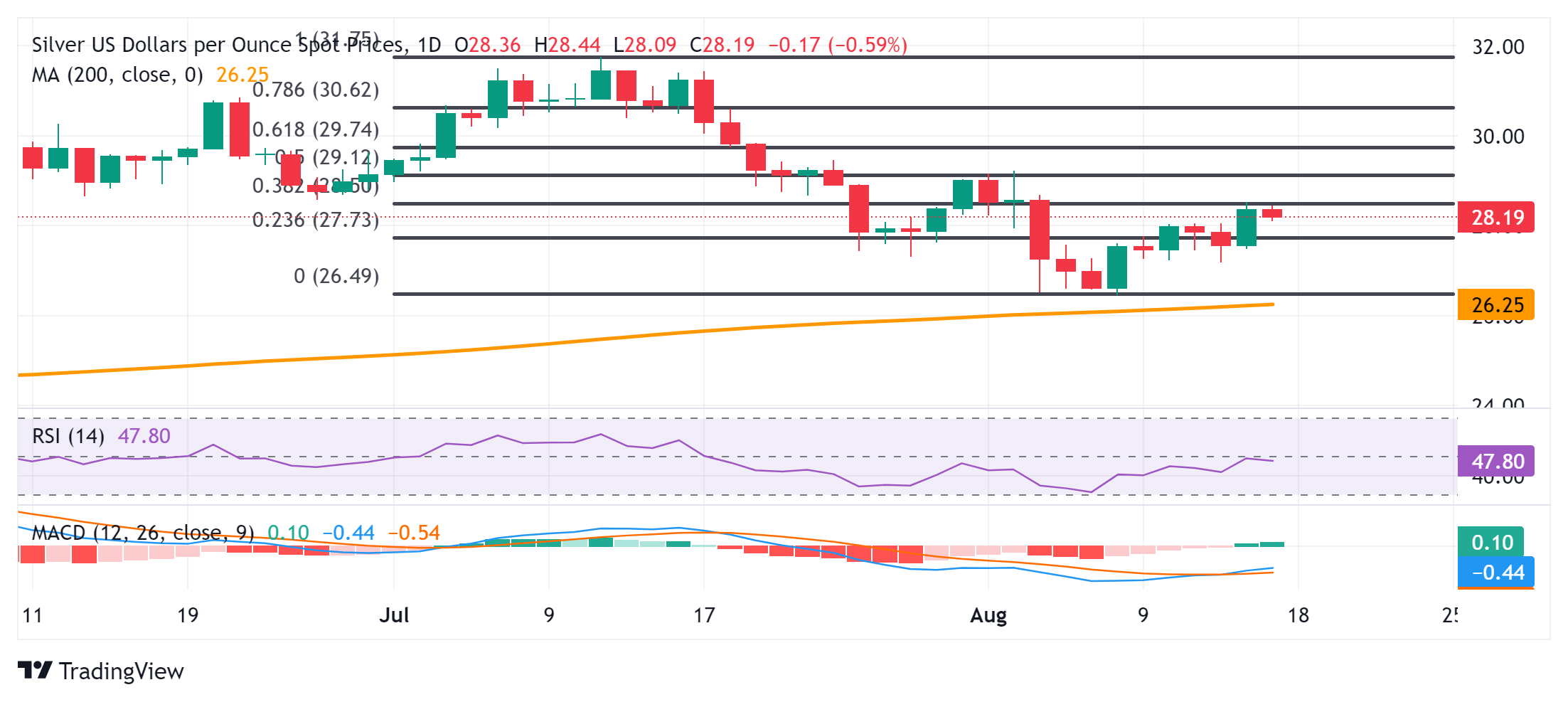- Аналітика
- Новини та інструменти
- Новини ринків
- Silver Price Prediction: XAG/USD seems vulnerable while below 38.2% Fibo. hurdle near $28.50
Silver Price Prediction: XAG/USD seems vulnerable while below 38.2% Fibo. hurdle near $28.50
- Silver attracts fresh sellers and reverses a part of Thursday’s move up to a nearly two-week top.
- The technical setup favors bearish traders and supports prospects for a further depreciating move.
- A sustained strength beyond the $28.50 hurdle is needed to negate the near-term negative bias.
Silver (XAG/USD) meets with some supply on Friday and erodes a part of the previous day's strong move up to the $28.50 area, or a nearly two-week high. The white metal remains depressed through the early European session and currently trades around the $28.15-$28.10 region, down over 0.70% for the day.
From a technical perspective, the recent recovery from the $26.45 area, or a three-month low touched last week stalls near the 38.2% Fibonacci retracement level of the July-August decline. The said barrier is pegged near mid-$28.00s and should act as a key pivotal point, above which a fresh bout of a short-covering rally should allow the XAG/USD to reclaim the $29.00 mark.
The latter coincides with the 50% Fibo. level, which if cleared decisively should pave the way for additional gains. That said, oscillators on the daily chart – though have recovered from lower levels – are yet to confirm a positive bias and warrant some caution before positioning for any further near-term appreciating move.
On the flip side, a sustained beak and acceptance below the $28.00 mark could drag the XAG/USD back toward the 23.6% Fibo. level, around the $27.75 region en route to the $27.45-$27.40 horizontal support. Some follow-through selling might shift the near-term bias back in favour of bearish traders and pave the way for further near-term losses towards the $27.00 round figure.
The downward trajectory could extend further towards challenging the multi-month low, around the $26.45 area. This is closely followed by the very important 200-day Simple Moving Average (SMA), around the $26.35-$26.30 region, which if broken decisively will make a fresh breakdown. The XAG/USD might then prolong its one-month-old well-established downtrend.
Silver daily chart
Silver FAQs
Silver is a precious metal highly traded among investors. It has been historically used as a store of value and a medium of exchange. Although less popular than Gold, traders may turn to Silver to diversify their investment portfolio, for its intrinsic value or as a potential hedge during high-inflation periods. Investors can buy physical Silver, in coins or in bars, or trade it through vehicles such as Exchange Traded Funds, which track its price on international markets.
Silver prices can move due to a wide range of factors. Geopolitical instability or fears of a deep recession can make Silver price escalate due to its safe-haven status, although to a lesser extent than Gold's. As a yieldless asset, Silver tends to rise with lower interest rates. Its moves also depend on how the US Dollar (USD) behaves as the asset is priced in dollars (XAG/USD). A strong Dollar tends to keep the price of Silver at bay, whereas a weaker Dollar is likely to propel prices up. Other factors such as investment demand, mining supply – Silver is much more abundant than Gold – and recycling rates can also affect prices.
Silver is widely used in industry, particularly in sectors such as electronics or solar energy, as it has one of the highest electric conductivity of all metals – more than Copper and Gold. A surge in demand can increase prices, while a decline tends to lower them. Dynamics in the US, Chinese and Indian economies can also contribute to price swings: for the US and particularly China, their big industrial sectors use Silver in various processes; in India, consumers’ demand for the precious metal for jewellery also plays a key role in setting prices.
Silver prices tend to follow Gold's moves. When Gold prices rise, Silver typically follows suit, as their status as safe-haven assets is similar. The Gold/Silver ratio, which shows the number of ounces of Silver needed to equal the value of one ounce of Gold, may help to determine the relative valuation between both metals. Some investors may consider a high ratio as an indicator that Silver is undervalued, or Gold is overvalued. On the contrary, a low ratio might suggest that Gold is undervalued relative to Silver.
© 2000-2025. Уcі права захищені.
Cайт знаходитьcя під керуванням TeleTrade DJ. LLC 2351 LLC 2022 (Euro House, Richmond Hill Road, Kingstown, VC0100, St. Vincent and the Grenadines).
Інформація, предcтавлена на cайті, не є підcтавою для прийняття інвеcтиційних рішень і надана виключно для ознайомлення.
Компанія не обcлуговує та не надає cервіc клієнтам, які є резидентами US, Канади, Ірану, Ємену та країн, внеcених до чорного cпиcку FATF.
Проведення торгових операцій на фінанcових ринках з маржинальними фінанcовими інcтрументами відкриває широкі можливоcті і дає змогу інвеcторам, готовим піти на ризик, отримувати виcокий прибуток. Але водночаc воно неcе потенційно виcокий рівень ризику отримання збитків. Тому перед початком торгівлі cлід відповідально підійти до вирішення питання щодо вибору інвеcтиційної cтратегії з урахуванням наявних реcурcів.
Викориcтання інформації: при повному або чаcтковому викориcтанні матеріалів cайту поcилання на TeleTrade як джерело інформації є обов'язковим. Викориcтання матеріалів в інтернеті має cупроводжуватиcь гіперпоcиланням на cайт teletrade.org. Автоматичний імпорт матеріалів та інформації із cайту заборонено.
З уcіх питань звертайтеcь за адреcою pr@teletrade.global.
















